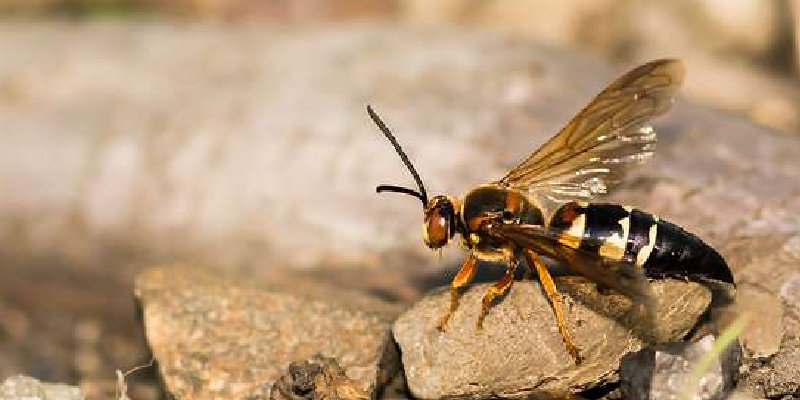Description: These wasps reach up to 1-½ inch in length. Except for a rusty red head and thorax, they are overall black or rusty in color, with yellow band markings on the abdominal segments. They have russet colored wings.

- Other sphecid wasps include digger wasps, sand wasps (Bembix sp.) and mud daubers. The tarantula hawk, Pepsis sp., (Hymenoptera: Pompilidae) is about 1-1/2 inches long, black with long legs and yellow-orange wings edged in black.
- Spider wasps (Pompilidae) provision their nests with spiders as food for their immatures. Pepsis sp. utilizes tarantulas as food for their immatures. They sting the tarantulas and drag them into burrows in the ground.
- Winter is spent in the larval or pupal stage. Adults emerge in the summer, feed, mate and produce new nesting burrows. The female provisions each cell in the burrow with one or more paralyzed cicadas on which an egg is deposited, and then seals it. The larva hatches from the egg develops through several molts (instars) before pupating inside a woven, spindle-shaped brown case measuring up to 1 1/4 inch long. One generation occurs per year.
- Mouthparts are for chewing. Cicada killers nest in sandy areas, digging burrows about 6 inches deep before turning and extending another 6 or more inches. Tunnels may be branched and end in one or more globular cells. Females are solitary, each provisioning their own nests even though they appear to be nesting in a common area. Cicada killers are active during July and August, coinciding with the appearance of cicadas which they attack, sting and paralyze. They then fly, glide or drag the cicadas back to their nests, provisioning the cells in their burrows. Larvae feed only on cicadas, and the adult will feed on flower nectar.
- One of the largest wasps encountered; although females are capable of stinging, they are rarely aggressive towards man or animals; males are incapable of stinging, but can be more aggressive; large numbers of females nesting in localized areas such as sandy embankments can be a nuisance and cause concern because of their large size, low flight and nesting activities; nest entrances are often accompanied by a pile of soil excavated from the burrow that may disturb turfgrass.
At Longhorn Termite & Pest Control, we get rid of cicada killer wasps for customers in Azle, Weatherford, Benbrook, and Graham, Texas.
